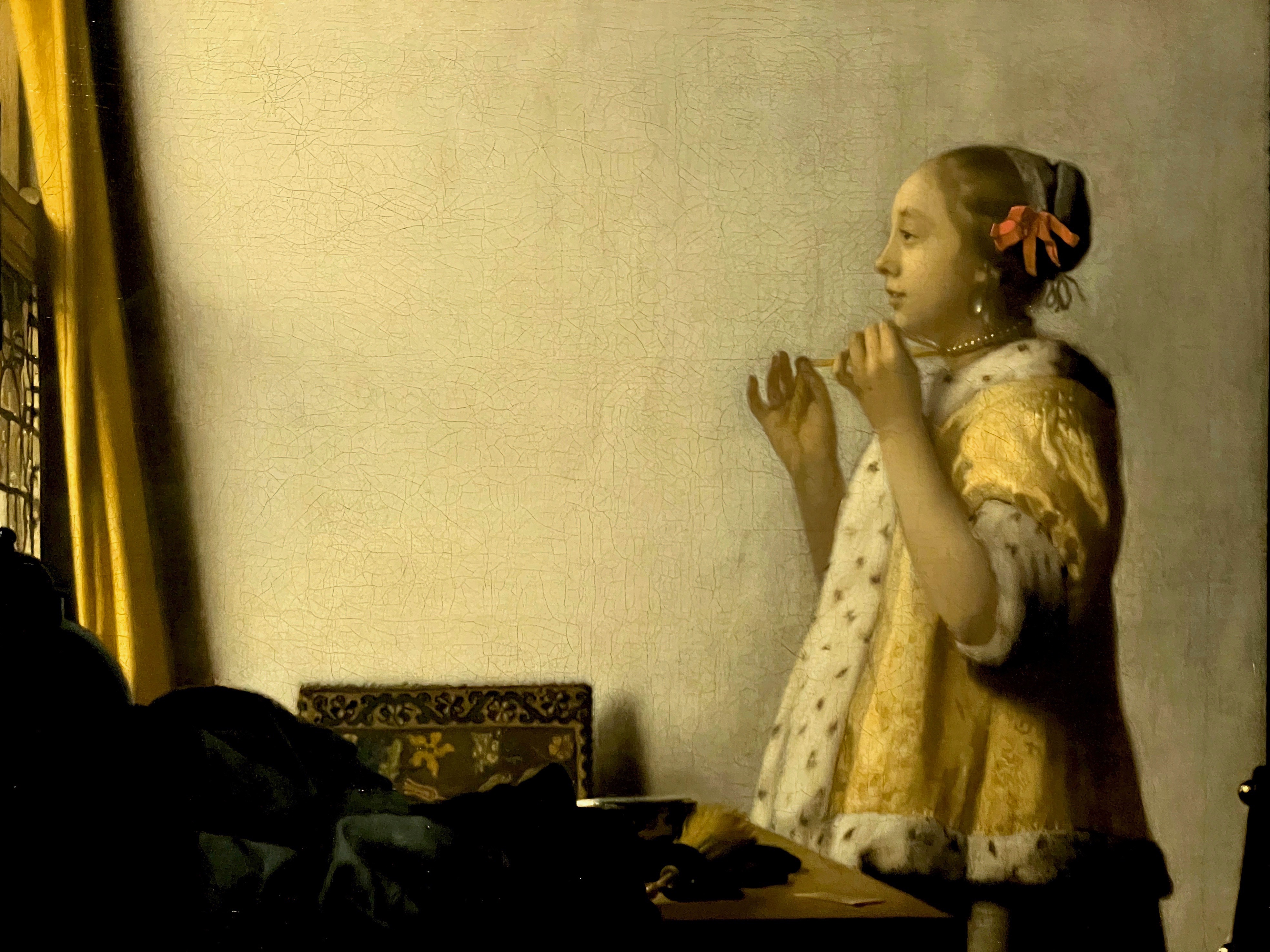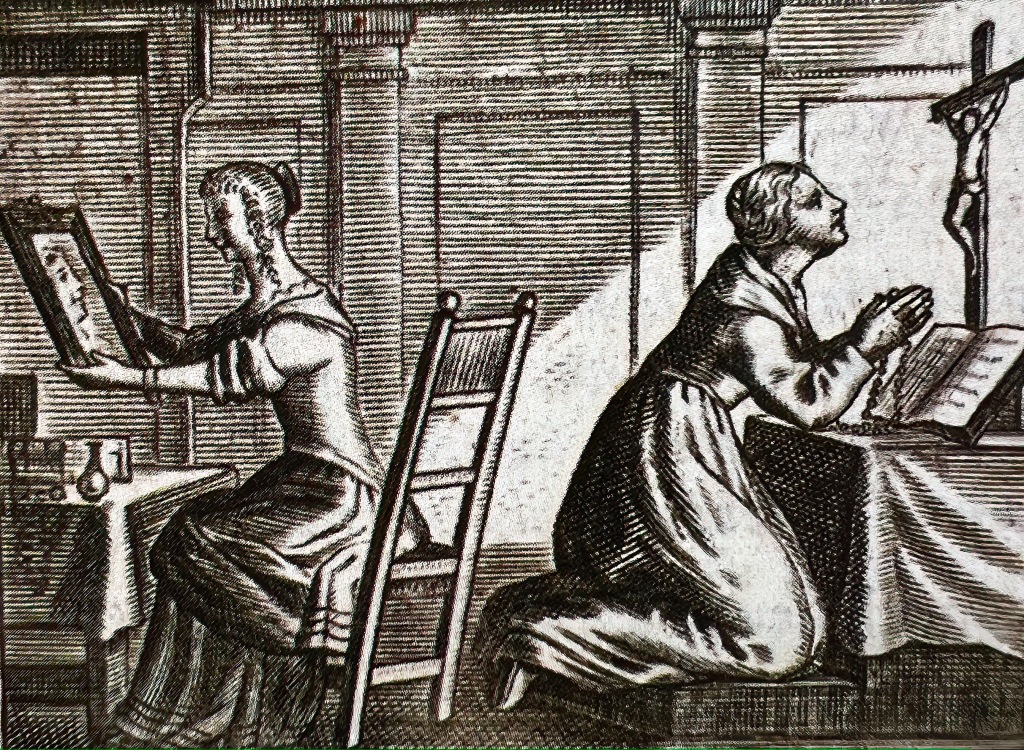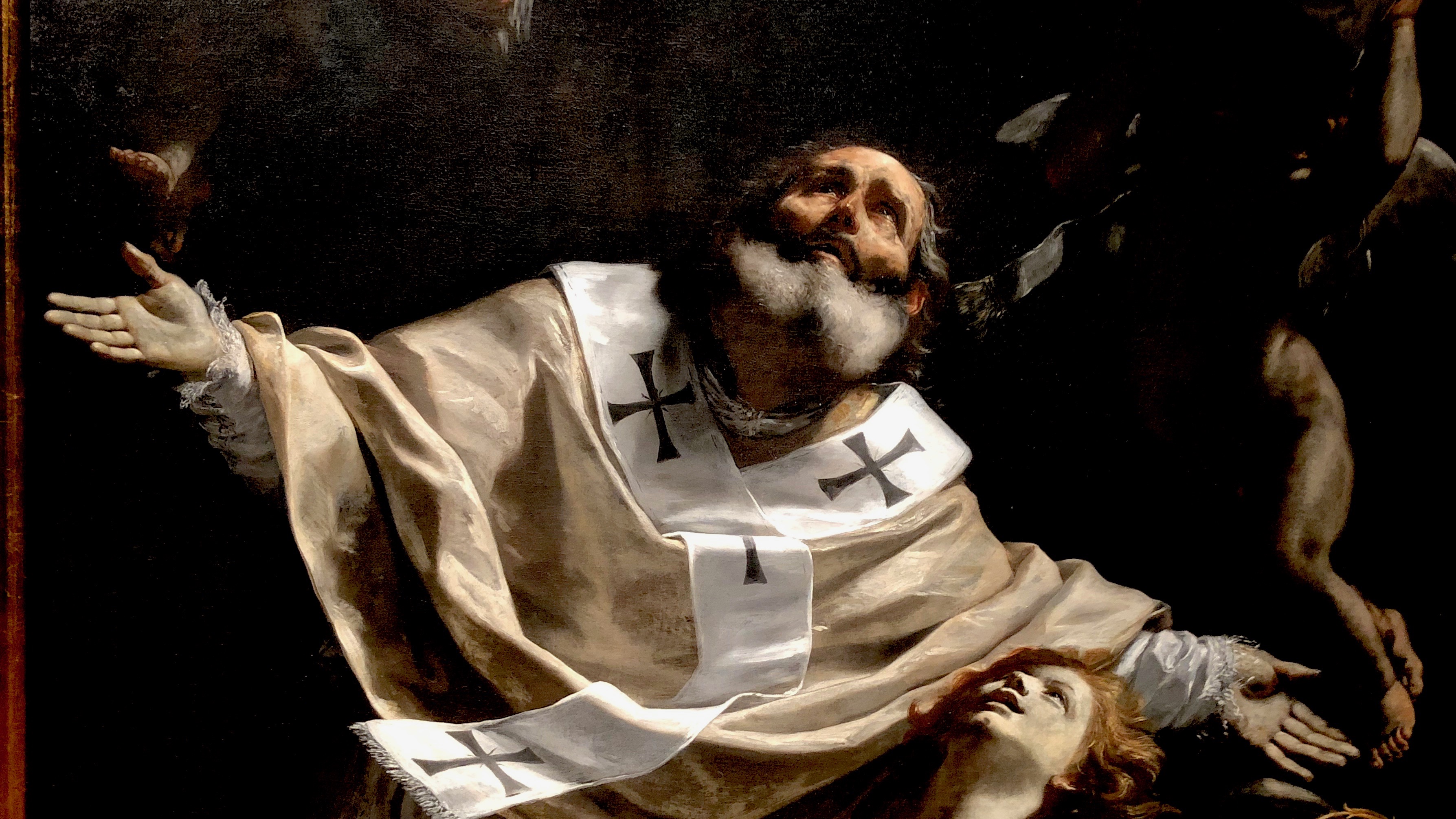
O voi ch’ avete li ‘ntelletti sani,
Marate la dottrina cha s’asconde
Sotto ‘l velame de li versi strani.
O you whose minds are sound and full of sense,
consider the deeper meaning hidden here
behind the veil of these strange verses.
— Dante Alighieri, Inferno IX.61-63
Epiphany is a visual season. The mystery of God among us is shown to the world. And this showing culminates with the visionary experience of the Transfiguration: the veil covering Christ’s divinity is pulled aside, and three of his friends are dazzled by the radiance. The stark clarity of this revelation lasts only a moment. Epiphanies are brief by nature. When Jesus and the disciples descend from the mountaintop, the gospel narrative returns us to a more “normal” reality.
What did the disciples actually see in that moment on the mountain? Gregory of Palamas, a 14th-century theologian, believed that they glimpsed something actual and substantial, which he called the “uncreated light.”
“Christ is transfigured,” he said, “not by putting on some quality he did not possess previously, nor by changing into something he never was before, but by revealing to his disciples what he truly was, in opening their eyes and in giving sight to those who were blind. For while remaining identical to what he had been before, he appeared to the disciples in his splendor; he is indeed the true light, the radiance of glory.” [i]
Whatever we make of Gregory’s metaphysical claims, which were disputed by many of his contemporaries, the spiritual resonance of light is undeniable and universal. It ialways seems to be about something more than physics. It seems inevitably imbued with Spirit.
Where does such light come from? Is it something that happens to our eyes but is not really in the world? Or is it somehow there, within the heart of things, “born of the one light Eden saw play?” Is it not just a simulacrum of divinity, but a direct manifestation? Opinion is divided on this question, but I myself side with the visionaries who say there is more to reality than meets the eye. At the very least, this makes for a more interesting—and radiant—universe. Thoreau put the alternative as well as any when he said, “I perceive that we inhabitants of New England live this mean life that we do because our vision does not penetrate the surface of things.” [ii]
In the 17th century, when the science of optics was expanding to match developments in the telescope, the microscope, and the camera obscura, Jesuit thinkers took a keen interest in both the science and the theology of light. Observable facts and theological metaphors were for them compatible and complementary ways of knowing reality.
In Ars magna lucis et umbrae (“The great art of light and shadow”), published in 1646, Athanasius Kircher, S.J., described Christ as the Light of the World who contains divine glory and manifests it to the visible realm. “For Kircher, the infinite and eternal light is God the Father, thus the Son is the light from the light. The divine light first became visible as a result of his incarnation.” [iii] It became common for his fellow Jesuits to employ optical phenomena in their devotional literature. The light from above, the light from within, the light which pierces the dark, the light which creates the visible world, and the light which illumines the mind of the receptive perceiver—all have their source in the eternal energies of God.

Last year I had the good fortune to see the exhibition of a lifetime: 28 paintings by Johannes Vermeer at Amsterdam’s Rijksmuseum. It was the largest number of his works ever assembled in one place, an historic event which may never be repeated. To be in the presence of those miracles of brush and pigment was an epiphany of the heart—three precious hours I will never forget.
According to art scholar Gregor J. M. Weber, Vermeer’s art was strongly influenced by the optical theology of the Jesuits. Light itself, simultaneously natural and transcendent, could be seen as the true subject of his pictures. Many of his images feature light pouring into an otherwise shadowy interior from a window on the left edge of the canvas. And even the defining lines of persons and objects, softened and blurred by subtle gradations of color and tone, seem on the verge of dematerializing into pure luminosity.

A striking example of this is Woman with a Pearl Necklace (c. 1662-1664). Its explicit content employs a common visual trope for worldly vanity. A fashionably dressed woman, clutching a pearl necklace, admires herself in a mirror. Similar images can be found in the engravings of Jesuit devotional books. This illustration from a 1682 Jesuit publication contrasts vanity before a mirror with piety before a crucifix.

While the mirror and the pearls in Vermeer’s painting were certainly “customary symbols of transience and vanity,” art historian Arthur K. Wheelock, Jr., argues that the woman’s priestly posture and the chaste beauty of the visual elements represent self-knowledge and truth. Perhaps. But Weber, making his case for Jesuit influence, focuses on the empty wall behind the preoccupied figure. In his original composition, Vermeer had darkened much of that wall with a large map. But then he painted out the map, leaving that wondrously glowing surface. “One must therefore ask,” writes Weber, “if the strikingly empty but bright white wall in Vermeer’s painting does not refer to God, invisible to the woman, fixated on her vain reflection—a metaphor for someone entangled in worldly things only.” [iv]
God is there all the time, in the form of light, but the woman is oblivious! I find that an attractive reading of the painting, because it educates my own spiritual vision. “Find God in all things,” said Jesuit founder Ignatius Loyola—even in a glowing wall. While riding the ferry to Seattle the other day, I did just that when I became absorbed by light reflected from Puget Sound onto the ceiling of the passenger cabin.
I knew factually that this light had traveled 93 million miles to be deflected upward by rippling water so it could dance upon the white ceiling above me. Still, it seemed charged with significance beyond the basic prose of solar optics: the miracle of light itself, without which nothing would be seen; the miracle of perception, enabling our own inwardness to connect with a reality beyond us; the inescapable sense of gift bestowed by luminosity and warmth; the ineffable poetics of glory, without which there would be neither beauty nor art nor religion.
I’m putting this badly, of course. I don’t have the right words. There may be no right words whatsoever. But as I sat transfixed by the bright pulsations, they felt like a semaphore from a transcendent source, delivering a message for which I simply lacked the code. Was it saying “I am with you always,” or “All shall be well”? For a moment as brief as the Transfiguration, the sense of something shown and something received was at the very least an inner truth, what faith calls the light of God shining in my heart. In a time of so much darkness, that’s no small thing.

Just three days after beholding the light of Transfiguration on the Last Sunday of Epiphany, we step through the gateway to Lent on Ash Wednesday. It’s quite a shift. For a brief moment, we see the divine light right in front of us—so close we can almost touch it. Then, just like that, we find ourselves back at the bottom of the mountain, where the only way to return to the light is the long and winding road through the desert of unknowing and unmaking.
That’s exactly how Dante’s Divine Comedy begins. Lost in a dark wood, alone and afraid, the pilgrim poet looks up. A steep hill rises before him, and behind its summit a tentative glow suggests an end to the dreadful night. The lively translation by Sandow Birk and Marcus Sanders conveys the hope awakened in the poet by this glimpse of dawning:
Just when / I was feeling completely lost and was ready to give up, / I looked up and saw a faint light in the distance. / I figured that meant there must be a way out up ahead / somewhere. When I saw that light, I felt better, and the / fear I’d been holding inside me that whole time started / to lift a little bit, because I figured I’d be outta there soon.[v]
So Dante starts to climb toward the saving Light. As Helen Luke put it in her Jungian study of the poem, “He wanted, as we all want, to go the shortest and the quickest way to his goal.” [vi] But his way was suddenly blocked by three fierce beasts—the leopard, the lion, and the wolf—representing all the malformed and misdirected energies and aggressions of the ego.

Realizing there could be no easy way out of his darkness, no direct path to the Light, Dante surrenders his ambition to conquer the luminous summit by his own strength. He stops climbing, turns around, and begins the initially downward course along the arduous road of purgation and rebirth. Helen Luke sees in this radical change of itinerary an archetype for every spiritual journey:
“So indeed do we learn, struggling out of the dark wood, that we cannot hope to find wholeness by repressing the shadow sides of ourselves, or by the most heroic efforts of the ego to climb up, to achieve goodness. The leopard, the lion, and the wolf will not allow it, we may thank God. It is when we admit our powerlessness that the guide appears.” [vii]
For Dante, the guide is Virgil, the long-dead poet who has been his greatest literary inspiration. In William Blake’s dramatic illustration, the beasts as well as Dante’s red garment signify turbulent emotion, while the soothing blue of Virgil’s gown suggests the transcendent imagination which nourishes hope and peace even in the abyss.
“I entreat you,” Dante tells his guide, “take me to the places I must go, that I may escape this evil and much worse.” [viii] And so they descend together, into the existential abyss of pain and woundedness, on a journey which will, by God’s grace, lead upward in the end, to the Light that cleaves every darkness.
In the Transfiguration story, the disciples are also looking for a shortcut to wholeness. If only they could stay on the summit, clinging to the vision of Love’s brilliance. But Jesus, their own wise guide, takes them down the slope to resume the Way of the Cross: the long but necessary path of negation and affirmation, losing and finding, dying and rising.
Perhaps we ourselves would rather skip Lent, or at least Holy Week, and go straight to the cheering New Fire of the Easter Vigil. But there are no shortcuts. Still, even in the desert time of trial, the vision on the mountain can be rekindled and sustained by the burning bushes along the way—if only we turn aside to see them!

[i] St. Gregory Palamas, The Triads, in Richard Harries, Art and the Beauty of God: A Christian Understanding (London: Mowbray, 1993), 85
[ii] Henry David Thoreau, Walden (1854).
[iii] Gregor J.M. Weber, Johannes Vermeer: Faith, Light and Reflection (Amsterdam: Rijksmuseum, 2022), 89.
[iv] Ibid., 131-132.
[v] Sandow Birk & Marcus Sanders, Dante’s Inferno (San Francisco: Chronicle Books, 2004), 2.
[vi] Helen Luke, Dark Wood to White Rose: Journey and Transformation in Dante’s Divine Comedy (New York: Parabola Books, 1989), 5.
[vii] Ibid., 7.
[viii] Inferno I.130-132.












